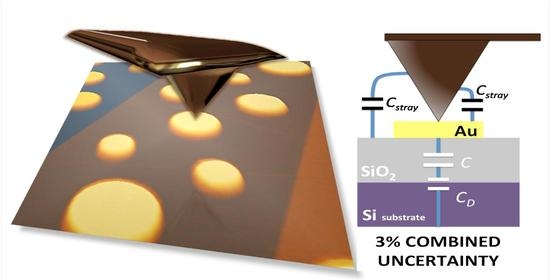Progress in Traceable Nanoscale Capacitance Measurements Using Scanning Microwave Microscopy
Abstract
:1. Introduction
2. Materials and Methods
2.1. Experimental Set-Up
2.2. Samples
2.3. Calibration Methods
- (i)
- Single topographic and S11,m images (phase and magnitude) of the selected capacitor triplet of the reference sample to check the validity of the SMM calibration procedure (i.e., modified SOL method);
- (ii)
- Single topographic and S11,m images of capacitors on the sample under study;
- (iii)
- Single topographic and S11,m images of the reference capacitor triplet to check the stability of the SMM calibration.
3. Results
3.1. Capacitance Reference Standards
3.1.1. Capacitance Model
3.1.2. Determination of the Dimensional Parameters
3.1.3. Uncertainty Budget on the Capacitance Calculation
3.2. Capacitance Measurements Using Calibrated SMM
3.2.1. S11 and Capacitance Images
3.2.2. SMM Calibrations
3.2.3. Capacitance Comparisons
4. Discussion
Author Contributions
Funding
Institutional Review Board Statement
Informed Consent Statement
Data Availability Statement
Acknowledgments
Conflicts of Interest
Appendix A. Analytical Expression of Oxide Layer Capacitance

Appendix B. Determination of Doping Concentration on MC2 Samples through Resistance Measurements
| A45 | A61 | A64 | |
|---|---|---|---|
| ρ (mΩ·cm) | 10.67 ± 0.03 | 10.41 ± 0.10 | 10.05 ± 0.05 |
| Na (1018 atoms/cm3) | 7.9 ± 0.3 | 8.2 ± 0.3 | 8.5 ± 0.3 |
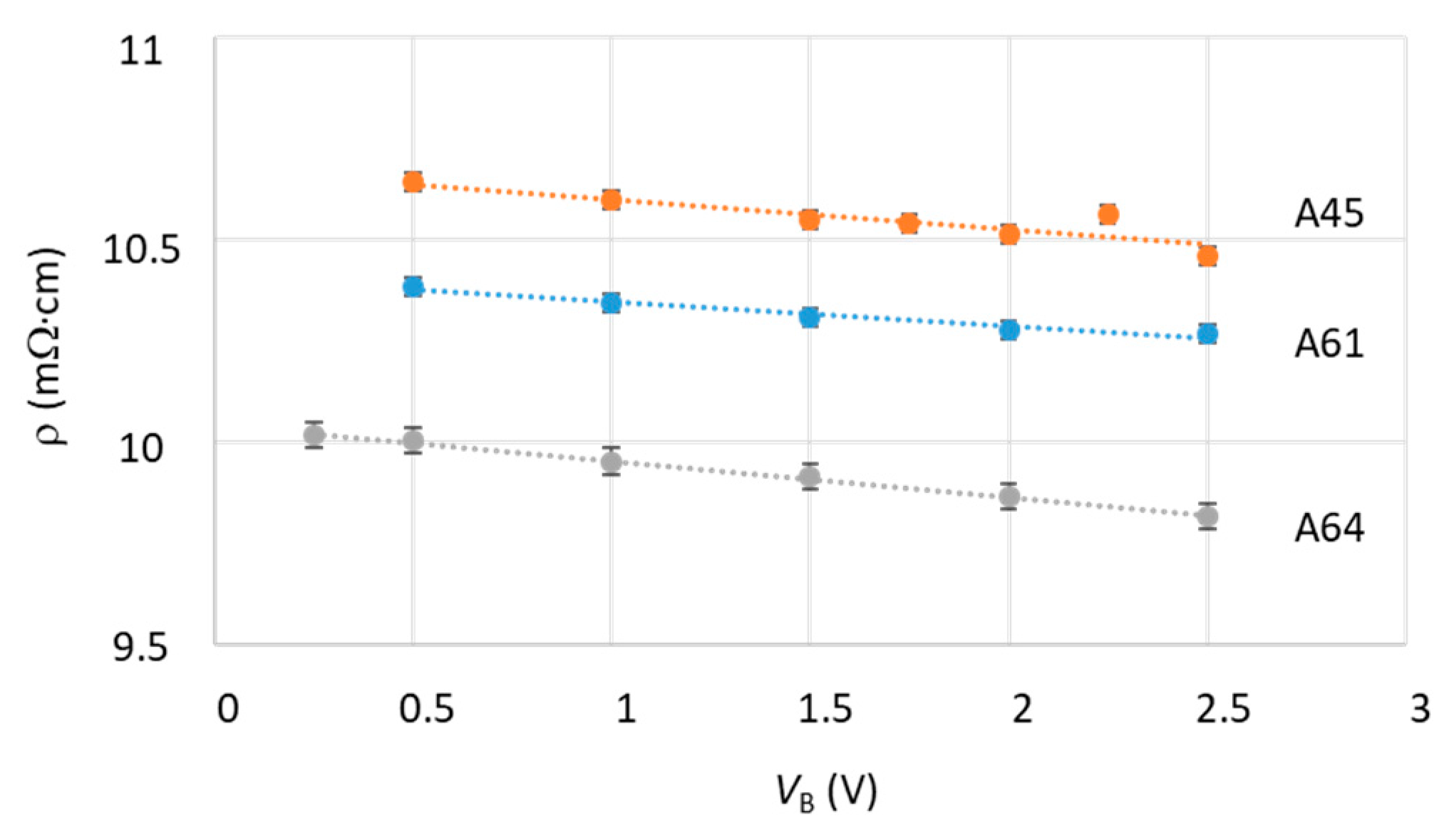
Appendix C. Stray Capacitances
| C05 | C23 | C32 | |
|---|---|---|---|
| Measured capacitance (fF) | 8.79 | 1.36 | 0.33 |
| Apex uapex,i | <10−5 | <10−4 | <10−4 |
| Lever ulever,i | 2 × 10−4 | 1.5 × 10−3 | 6.1 × 10−3 |
| Cone ucone,i | 1.4 × 10−4 | 9.5 × 10−4 | 3.9 × 10−3 |
| Total uncertainty ustray (%) | 0.02 | 0.18 | 0.72 |
Appendix D. Measurement Method for the Study on Relative Humidity Effect
- (i)
- S11 measurements on A64G07 pattern and SMM calibration by converting S11 to capacitance with the reference triplet (05,13,48) from A64G07;
- (ii)
- Two capacitance images by scanning back and forth the A64I05 pattern to reduce possible errors due to thermal drift and pressure variation;
- (iii)
- One capacitance image of A64G07 pattern to check the stability of the SMM calibration.

References
- ITRS. Metrology. International Technology Roadmap for Semiconductors 2.0. 2015. Available online: www.semiconductors.org (accessed on 25 February 2021).
- IRDS. Metrology. International Technology Roadmap for Devices and Systems. 2018. Available online: www.irds.ieee.org (accessed on 25 February 2021).
- Bottoms, B. 2019 HIR Chapter 15: Materials and Emerging Research Materials. 2019. Available online: https://eps.ieee.org/technology/heterogeneous-integration-roadmap/2019-edition.html (accessed on 25 February 2021).
- Kingon, A.I.; Maria, J.; Streiffer, S.K. Alternative dielectrics to silicon dioxide for memory and logic devices. Nature 2000, 406, 1032–1038. [Google Scholar] [CrossRef]
- Robertson, J. High dielectric constant oxides. Eur. Phys. J. Appl. Phys. 2004, 28, 265–291. [Google Scholar] [CrossRef] [Green Version]
- Yim, K.; Yong, Y.; Lee, J.; Lee, K.; Nahm, H.H.; Yoo, J.; Lee, C.; Hwang, C.S.; Han, S. Novel high-Κ dielectrics for next-generation electronic devices screened by automated ab initio calculations. NPG Asia Mater. 2015, 7, e190. [Google Scholar] [CrossRef]
- Son, J.Y.; Shin, Y.H.; Kim, H.; Jang, H.M. NiO resistive random access memory nanocapacitor array on graphene. ACS Nano 2010, 4, 2655–2658. [Google Scholar] [CrossRef]
- Karbassi, A.; Ruf, D.; Bettermann, A.D.; Paulson, C.A.; van der Weide, D.W. Quantitative scanning near-field microwave microscopy for thin film dielectric constant measurement Quantitative scanning near-field microwave microscopy for thin film dielectric constant measurement. Rev. Sci. Instrum. 2008, 79, 094706. [Google Scholar] [CrossRef]
- Huber, H.P.; Moertelmaier, M.; Wallis, T.M.; Chiang, C.J.; Hochleitner, M.; Imtiaz, A.; Oh, Y.J.; Schilcher, K.; Dieudonne, M.; Smoliner, J.; et al. Calibrated nanoscale capacitance measurements using a scanning microwave microscope. Rev. Sci. Instrum. 2010, 81, 113701. [Google Scholar] [CrossRef] [PubMed]
- Hoffmann, J.; Wollensack, M.; Zeier, M.; Niegemann, J.; Huber, H. A Calibration Algorithm for Nearfield Scanning Microwave Microscopes. In Proceedings of the 12th IEEE International Conference on Nanotechnology, IEEE-NANO, Birmingham, UK, 20–23 August 2012; pp. 1–4. [Google Scholar]
- Dargent, T.; Haddadi, K.; Lasri, T.; Clément, N.; Ducatteau, D.; Legrand, B.; Tanbakuchi, H.; Theron, D. An interferometric scanning microwave microscope and calibration method for sub-fF microwave measurements. Rev. Sci. Instrum. 2013, 84, 123705. [Google Scholar] [CrossRef] [PubMed] [Green Version]
- Gramse, G.; Kasper, M.; Fumagali, L.; Hinterdorfer, P.; Kienberger, F. Calibrated complex impedance and permittivity measurements with scanning microwave microscopy. Nanotechnology 2014, 25, 145703. [Google Scholar] [CrossRef]
- Wang, F.; Clément, N.; Ducatteau, D.; Troadec, D. Quantitative impedance characterization of sub-10 nm scale capacitors and tunnel junctions with an interferometric scanning microwave microscope. Nanotechnology 2014, 25, 405703. [Google Scholar] [CrossRef] [Green Version]
- Hoffmann, J.; Gramse, G.; Niegemann, J.; Zeier, M.; Kienberger, F.; Hoffmann, J.; Gramse, G.; Niegemann, J.; Zeier, M. Measuring low loss dielectric substrates with scanning probe microscopes. Appl. Phys. Lett. 2014, 105, 013102. [Google Scholar] [CrossRef]
- Tuca, S.-S.; Kasper, M.; Kienberger, F.; Gramse, G. Interferometer Scanning Microwave Microscopy. IEEE Trans. Nanotechnol. 2017, 16, 991–998. [Google Scholar]
- Biagi, M.C.; Badino, G.; Fabregas, R.; Gramse, G.; Fumagalli, L.; Gomila, G. Direct Mapping of the Electric Permittivity of Heterogeneous Non-Planar Thin Films at Gigahertz Frequencies by Scanning microwave microscopy. Phys. Chem. Chem. Phys. 2017, 19, 3884–3893. [Google Scholar] [CrossRef] [Green Version]
- Horibe, M.; Kon, S.; Hirano, I. Measurement Capability of Scanning Microwave Microscopy: Measurement Sensitivity Versus Accuracy. IEEE Trans. Instrum. Meas. 2019, 68, 1774–1780. [Google Scholar] [CrossRef]
- Gramse, G.; Casuso, I.; Toset, J.; Fumagalli, L.; Gomila, G. Quantitative dielectric constant measurement of thin films by DC electrostatic force microscopy. Nanotechnology 2009, 20, 395702. [Google Scholar] [CrossRef] [PubMed]
- Farina, M.; Mencarelli, D.; Di Donato, A.; Venanzoni, G.; Morini, A. Calibration protocol for broadband near-field microwave microscopy. IEEE Trans. Microw. Theory Tech. 2011, 59, 2769–2776. [Google Scholar] [CrossRef]
- Le Quang, T.; Gungor, A.C.; Vasyukov, D.; Hoffmann, J.; Smajic, J.; Zeier, M. Advanced calibration kit for scanning microwave microscope: Design, fabrication, and measurement. Rev. Sci. Instrum. 2021, 92, 023705. [Google Scholar] [CrossRef]
- Moran, J.; Delvallée, A.; Allal, D.; Piquemal, F. A substitution method for nanoscale capacitance calibration using scanning microwave microscope. Meas. Sci. Technol. 2020, 31, 074009. [Google Scholar] [CrossRef]
- Delvallée, A.; Feltin, N.; Ducourtieux, S.; Trabelsi, M.; Hochepied, J.F. Toward an uncertainty budget for measuring nanoparticles by AFM. Metrologia 2016, 53, 41–50. [Google Scholar] [CrossRef]
- Crouzier, L.; Delvallée, A.; Ducourtieux, S.; Devoille, L.; Noircler, G.; Ulysse, C.; Taché, O.; Barruet, E.; Tromas, C.; Feltin, N. Development of a new hybrid approach combining AFM and SEM for the nanoparticle dimensional metrology. Beilstein J. Nanotechnol. 2019, 10, 1523–1536. [Google Scholar] [CrossRef] [Green Version]
- Ducourtieux, S.; Poyet, B. Development of a metrological atomic force microscope with minimized Abbe error and differential interferometer-based real-time position control. Meas. Sci. Technol. 2011, 22, 094010. [Google Scholar] [CrossRef]
- JCGM. Evaluation of Measurement Data—Guide to the expression of uncertainty in measurement. JCGM 100. 2008. Available online: https://www.bipm.org/en/publications/guides/gum.html (accessed on 25 February 2021).
- Kasper, M.; Gramse, G.; Hoffmann, J.; Gaquiere, C.; Feger, R.; Stelzer, A.; Smoliner, J.; Kienberger, F. Metal-oxide-semiconductor capacitors and Schottky diodes studied with scanning microwave microscopy at 18 GHz Metal-oxide-semiconductor capacitors and Schottky diodes studied with scanning microwave microscopy at 18 GHz. J. Appl. Phys. 2014, 116, 184301. [Google Scholar] [CrossRef] [Green Version]
- Nečas, D.; Klapetek, P. Gwyddion: An open-source software for SPM data analysis. Cent. Eur. J. Phys. 2012, 10, 181–188. [Google Scholar] [CrossRef]
- Janezic, M.D.; Arz, U.; Begley, S.; Bartley, P.; Technologies, A.; Rosa, S. Improved Permittivity Measurement of Dielectric Substrates by use ofthe TE111 Mode of a Split-Cylinder Cavity. In Proceedings of the 73rd ARFTG Microwave Measurement Conference, Boston, MA, USA, 12 June 2009; pp. 1–3. [Google Scholar]
- CODATA. CODATA Recommended values of the fundamental physical constants: 2018. NIST 2019, 961. [Google Scholar]
- Sloggett, G.J.; Barton, N.G.; Spencer, S.J. Fringing fields in disc capacitors. J. Phys. A. Math. Gen. 1986, 19, 2725–2736. [Google Scholar] [CrossRef]
- Sze, S.M.; Ng, K.K. Physics of Semiconductor Devices, 3rd ed.; John Wiley & Sons, Inc.: Hoboken, NJ, USA, 2007; ISBN 0-471-14323-5. [Google Scholar]
- Fumagalli, L.; Ferrari, G.; Sampietro, M.; Casuso, I.; Mart, E. Nanoscale capacitance imaging with attofarad resolution using ac current sensing atomic force microscopy. Nanotechnology 2006, 17, 4581. [Google Scholar] [CrossRef]
- Fumagalli, L.; Ferrari, G.; Sampietro, M.; Gomila, G. Dielectric-constant measurement of thin insulating films at low frequency by nanoscale capacitance microscopy. Appl. Phys. Lett. 2007, 91, 15–18. [Google Scholar] [CrossRef]
- Gomila, G.; Gramse, G.; Fumagalli, L. Finite-size effects and analytical modeling of electrostatic force microscopy applied to dielectric films. Nanotechnology 2014, 25, 255702. [Google Scholar] [CrossRef]
- Lányi, Š. Effect of adsorbed water on the resolution of scanning capacitance microscopes. Surf. Interface Anal. 1999, 27, 348–353. [Google Scholar] [CrossRef]
- Weeks, B.L.; DeYoreo, J.J. Dynamic meniscus growth at a scanning probe tip in contact with a gold substrate. J. Phys. Chem. B 2006, 110, 10231–10233. [Google Scholar] [CrossRef]
- Wu, B.Y.; Sheng, X.Q.; Fabregas, R.; Hao, Y. Full-wave modeling of broadband near field scanning microwave microscopy. Sci. Rep. 2017, 7, 16064. [Google Scholar] [CrossRef] [Green Version]
- Bulucea, C. Recalculation of Irvin’s resistivity curves for diffused layers in silicon using updated bulk resistivity data. Solid State Electron. 1993, 36, 489–493. [Google Scholar] [CrossRef]
- Smits, F.M. Measurement of Sheet Resistivities with the Four-Point Probe. Bell Syst. Tech. J. 1958, 37, 711–718. [Google Scholar] [CrossRef]

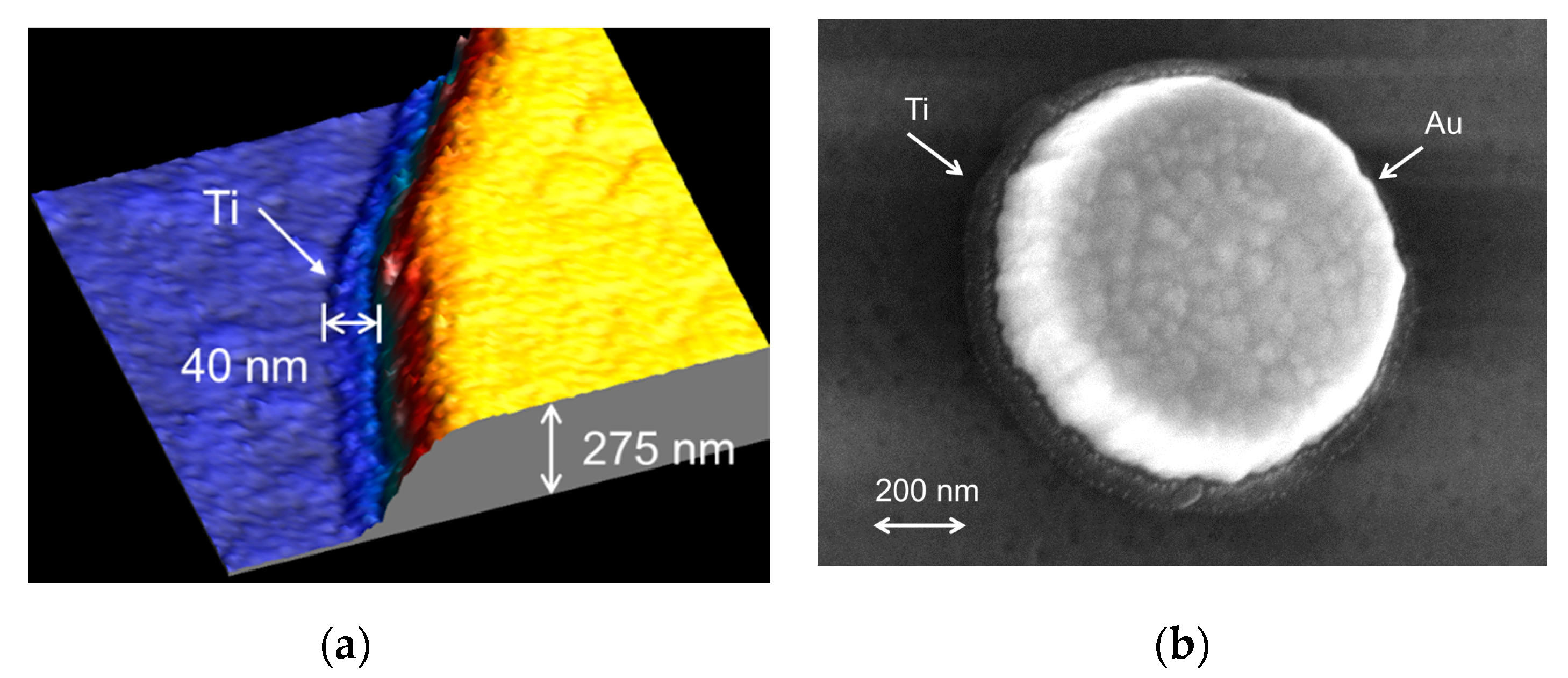



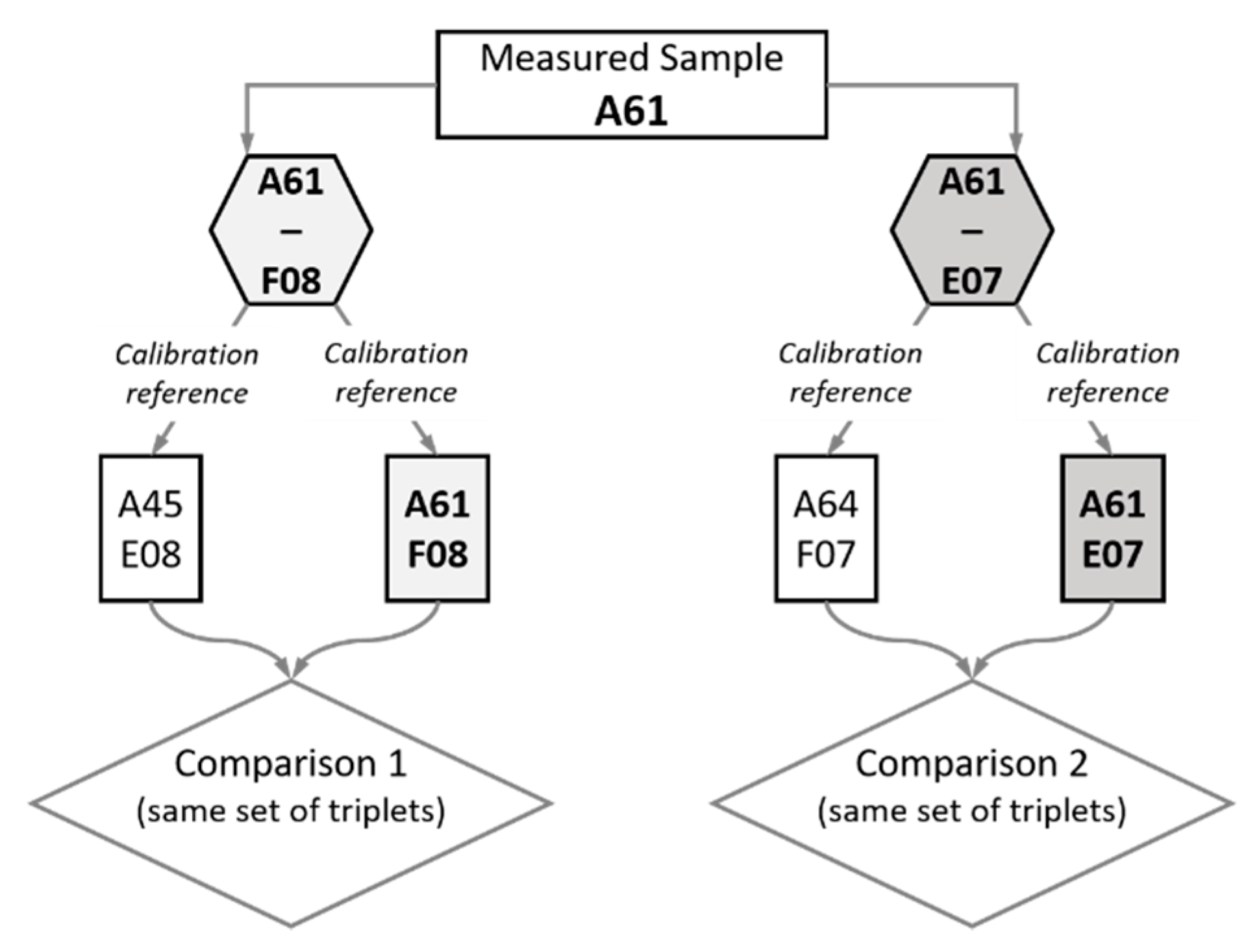
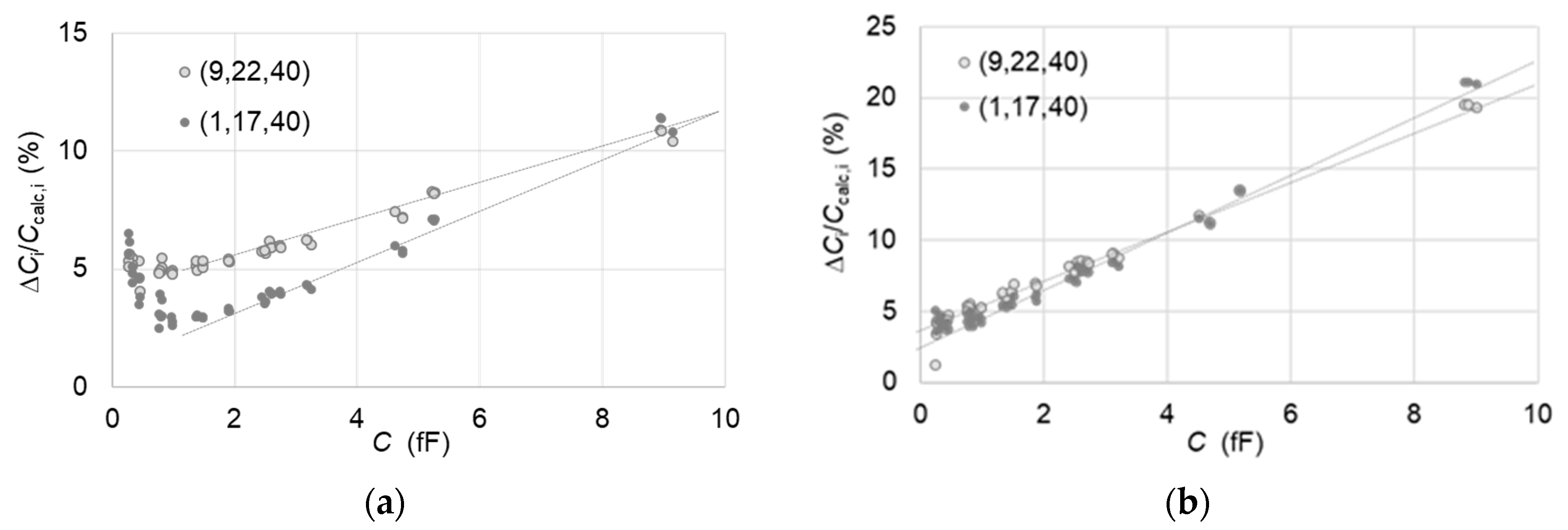
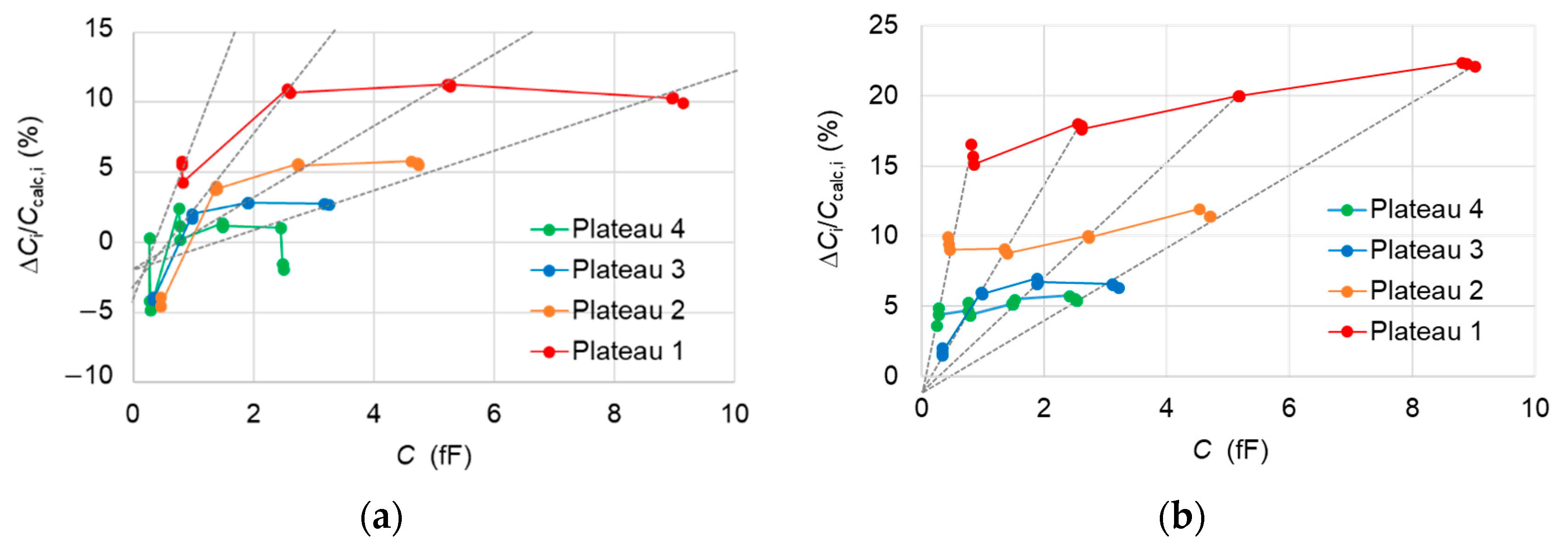


| d (nm) | |||
|---|---|---|---|
| Plateau | A61 | A45 | A64 |
| 1 | 53.1 ± 0.7 | 55.4 ± 0.7 | 53.1 ± 0.7 |
| 2 | 107.1 ± 0.8 | 105.1 ± 0.8 | 102.5 ± 0.8 |
| 3 | 162.8 ± 1.2 | 157.7 ± 1.2 | 154.2 ± 1.2 |
| 4 | 218.1 ± 1.5 | 208.6 ± 1.5 | 204.4 ± 1.5 |
| A61F08 | A64F07 | A45E08 | |||
|---|---|---|---|---|---|
| Triplet | Ccalc (fF) | Triplet | Ccalc (fF) | Triplet | Ccalc (fF) |
| C01 | 8.94 ± 0.24 | C05 | 9.16 ± 0.26 | C09 | 8.68 ± 0.24 |
| C17 | 4.62 ± 0.09 | C13 | 4.96 ± 0.09 | C13 | 4.78 ± 0.09 |
| C40 | 0.27 ± 0.01 | C48 | 0.29 ± 0.01 | C48 | 0.30 ± 0.01 |
| Uncertainty Budget | Type | C01,C05,C09 (4 µm, plateau 1) | C13, C17 (4 µm, plateau 2) | C40, C48 (1 µm, plateau 4) |
|---|---|---|---|---|
| Area measurements, uA | A, B | 0.9 | 0.9 | 2.4 |
| Thickness measurements, ud | A, B | 1.3 | 0.8 | 0.7 |
| Permittivity εr (SiO2), uε | B | 1.0 | 1.0 | 1.0 |
| Depletion capacitance, uCd | B | 2.0 (4.4) | 1.0 (2.3) | 0.8 (1.7) |
| Numerical modelling (COMSOL) | B | 0.1 | 0.1 | 0.1 |
| Combined uncertainty uC (%) | 2.7 | 1.9 | 2.8 |
| Uncertainties | C01, C05, C09 | C13, C17 | C40, C48 |
|---|---|---|---|
| Repeatability (Type A) | 0.2 | 0.2 | 0.3 |
| Image resolution (Type B) | 0.8 | 0.8 | 2.3 |
| Pitch AFM calibration (Type B) | 0.2 | 0.2 | 0.2 |
| Area correction (Type B) | 0.2 | 0.2 | 0.8 |
| Combined uncertainty uA (%) | 0.9 | 0.9 | 2.4 |
| C05 | C23 | C32 | |
|---|---|---|---|
| Capacitance (fF) | (8.79 ± 0.19) | (1.36 ± 0.04) | (0.33 ± 0.01) |
| Type A uncertainty uA,i (%) | 0.5 | 1.3 | 2.1 |
| uhisto,i | 0.1 | 0.6 | 2.1 |
| urep,i | 0.5 | 1.1 | 0.2 |
| Type B uncertainty uB,i (%) | 2.1 | 2.9 | 2.6 |
| uSMM,i | 2.1 | 2.9 | 2.5 |
| Others | 0.2 | 0.3 | 0.8 |
| Combined uncertainty u (%) | 2.2 | 3.2 | 3.3 |
Publisher’s Note: MDPI stays neutral with regard to jurisdictional claims in published maps and institutional affiliations. |
© 2021 by the authors. Licensee MDPI, Basel, Switzerland. This article is an open access article distributed under the terms and conditions of the Creative Commons Attribution (CC BY) license (http://creativecommons.org/licenses/by/4.0/).
Share and Cite
Piquemal, F.; Morán-Meza, J.; Delvallée, A.; Richert, D.; Kaja, K. Progress in Traceable Nanoscale Capacitance Measurements Using Scanning Microwave Microscopy. Nanomaterials 2021, 11, 820. https://doi.org/10.3390/nano11030820
Piquemal F, Morán-Meza J, Delvallée A, Richert D, Kaja K. Progress in Traceable Nanoscale Capacitance Measurements Using Scanning Microwave Microscopy. Nanomaterials. 2021; 11(3):820. https://doi.org/10.3390/nano11030820
Chicago/Turabian StylePiquemal, François, José Morán-Meza, Alexandra Delvallée, Damien Richert, and Khaled Kaja. 2021. "Progress in Traceable Nanoscale Capacitance Measurements Using Scanning Microwave Microscopy" Nanomaterials 11, no. 3: 820. https://doi.org/10.3390/nano11030820





